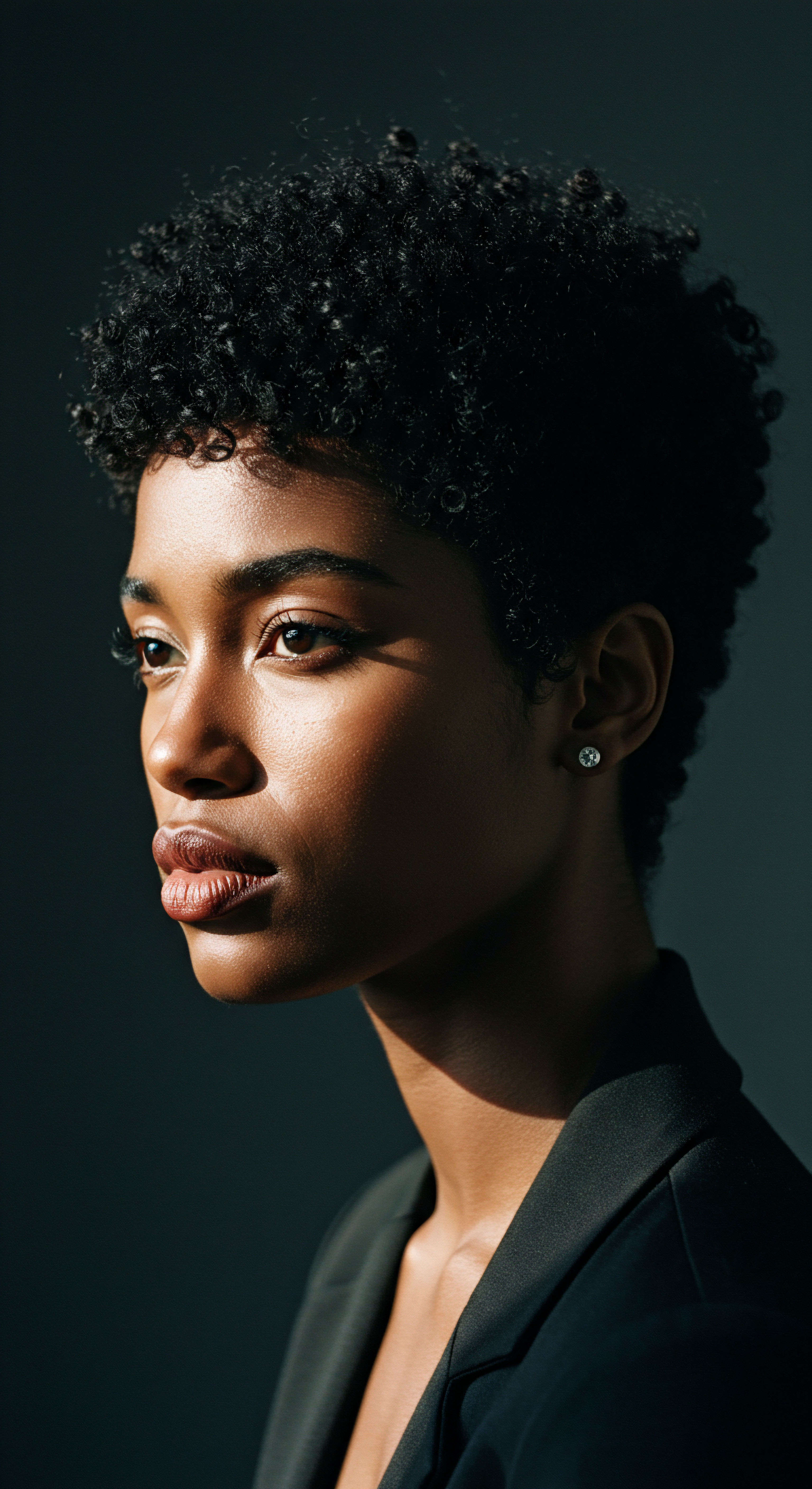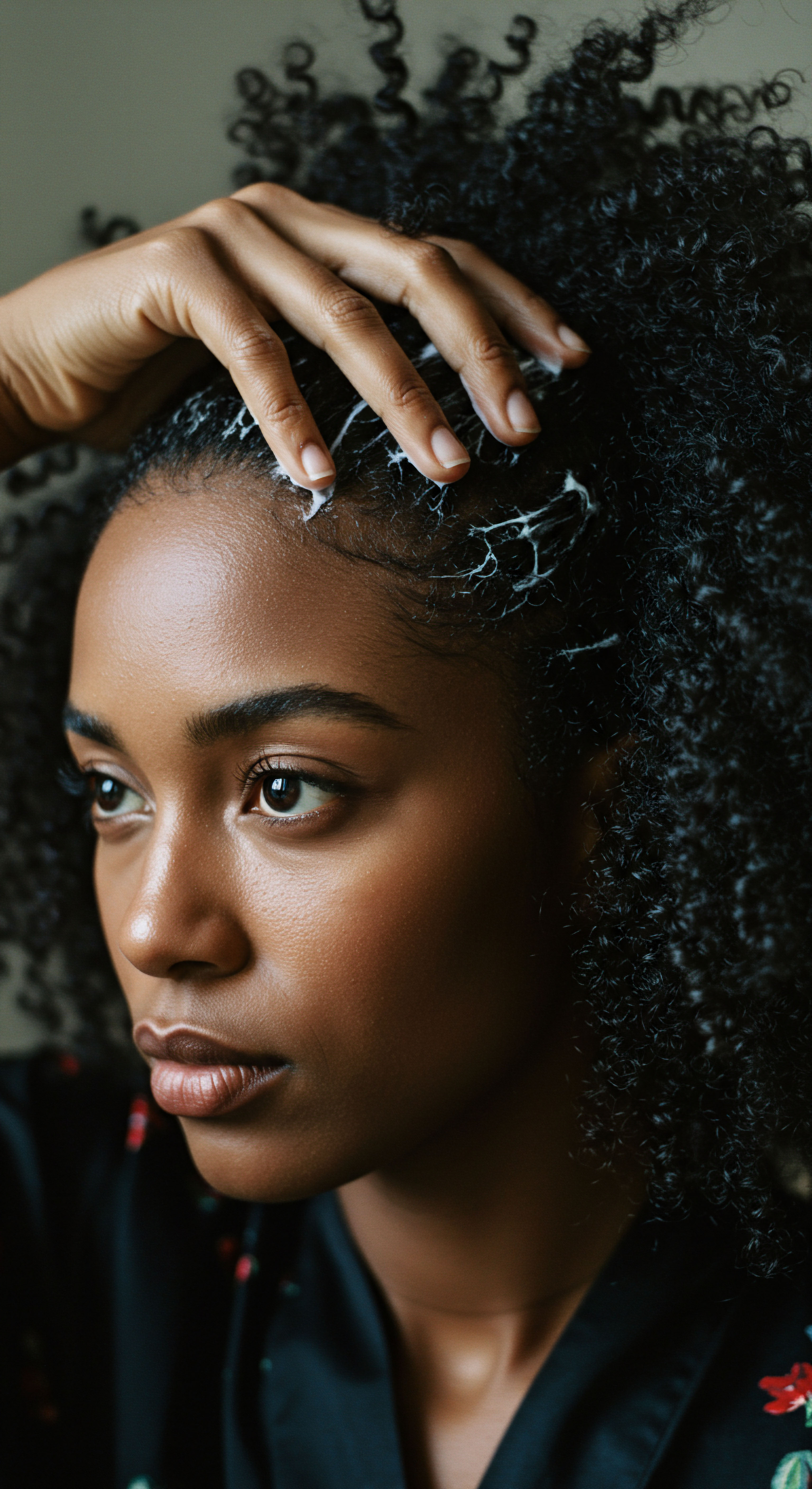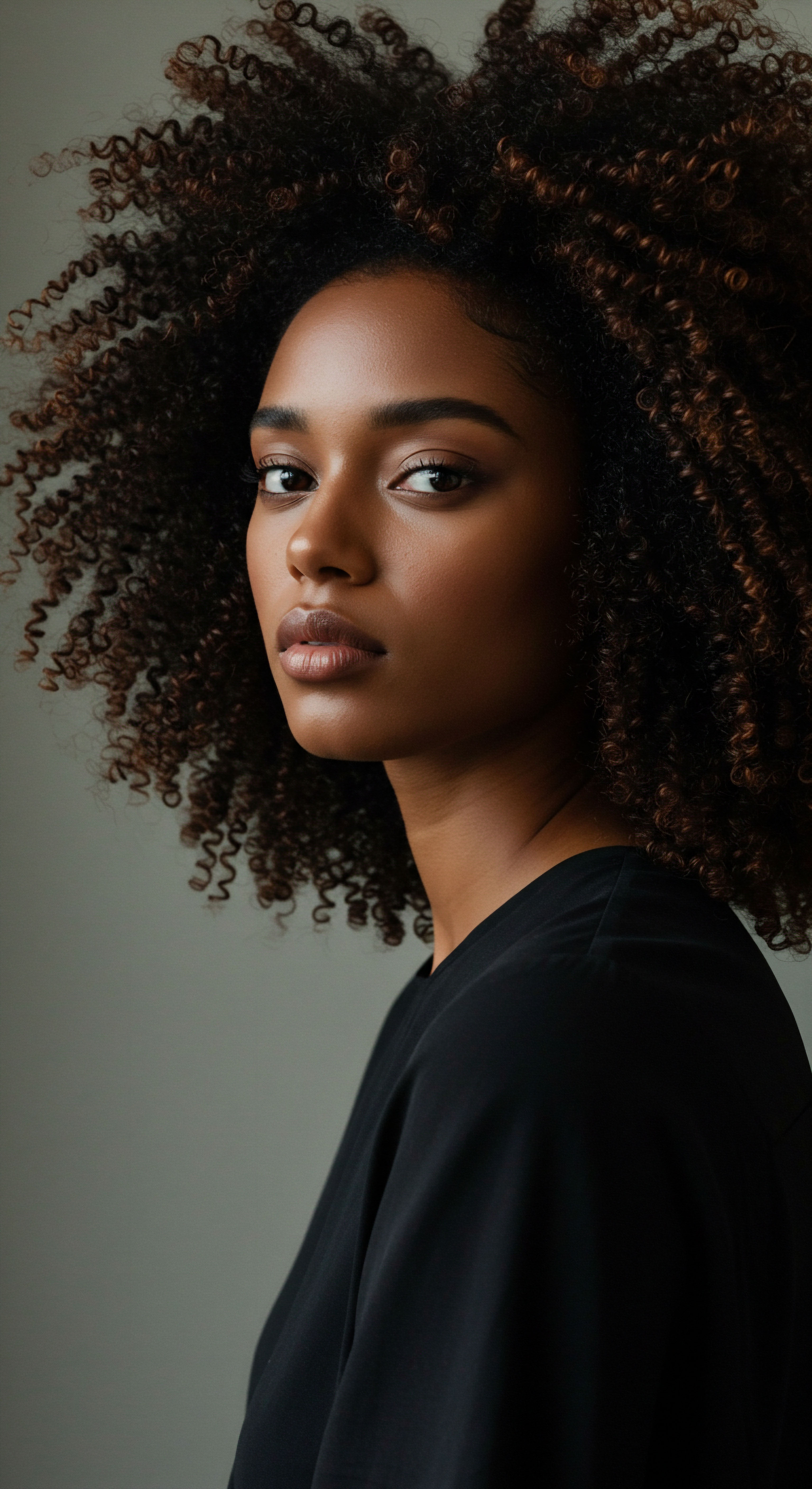
Roots
There exists a quiet understanding among those who care for textured strands ❉ the outward appearance of hair often whispers tales of inner wellness. We tend to focus on what we apply topically, the conditioners, the creams, the oils, hoping to smooth, soften, and fortify. Yet, what if the true origins of our hair’s resilience, its very integrity, lie not in bottles or jars, but within the nourishment we provide our bodies? This thought invites us to look deeper, beyond the surface sheen, into the foundational building blocks that determine our hair’s character.
At the cellular level, an intricate dance of lipids shapes the very essence of our hair, particularly the cuticle, that protective outer shield. Among these lipids, ceramides stand as unsung heroes, quiet guardians of moisture and strength. The question then arises, with a gentle curiosity ❉ can the choices we make at our tables truly influence these vital ceramide levels within our textured hair?

Understanding Hair’s Lipid Barrier
The hair shaft, a marvel of biological design, possesses a sophisticated protective system. Its outermost layer, the cuticle, comprises flattened, scale-like cells that overlap, much like shingles on a roof. This delicate structure acts as a primary defense, regulating moisture and guarding against external aggressors.
Integral to the cuticle’s robust function are its lipids, a family of fatty compounds that include ceramides, fatty acids, and cholesterol. These lipids form a laminated structure, a natural barrier that protects against environmental factors and maintains the hair’s integrity, hydrophobicity, moisture, and stiffness.
For textured hair, this lipid barrier carries particular significance. Despite often possessing a higher overall lipid content, Afro-textured hair frequently presents as dry or very dry. This apparent paradox stems from its unique structural characteristics, such as pronounced curvature and spiral hair follicles, which create points of weakness and increase susceptibility to moisture loss. The integrity of the ceramide content within this lipid layer becomes even more paramount for these hair types, as it directly influences their ability to retain hydration and resist damage.

What are Ceramides and Why Do They Matter for Hair?
Ceramides are a specific type of lipid, or fat, that plays a central role in maintaining the skin’s moisture barrier and, by extension, hair health. They are long-chain fatty acids that link with other molecules to encourage healthy cellular function. Within the hair cuticle, ceramides contribute to intercellular cohesion, acting as a kind of mortar between the cuticle’s “bricks,” holding cells together to create a protective shield.
This shield not only locks in hydration but also defends against irritants and supports resilience. Without adequate ceramides, the hair’s protective layer weakens, leading to dryness, brittleness, and increased susceptibility to breakage and split ends.
The significance of ceramides extends beyond simple protection. They contribute to the hair’s strength and elasticity, allowing strands to withstand the daily stresses of styling and environmental exposure. A well-moisturized and protected cuticle, supported by ample ceramides, reflects light more effectively, lending hair a natural luster. This makes ceramides a quiet force in maintaining the vibrancy and overall well-being of textured hair.
Ceramides, those quiet lipid guardians, stand as a cornerstone of hair’s inherent strength and moisture retention, particularly for textured strands.

How Do Ceramides Arrive in Hair?
Ceramides in hair originate from two primary sources ❉ internal lipids produced within hair matrix cells and external lipids from surface sebaceous glands. Interestingly, research indicates that while Asian hair tends to have higher levels of integral hair lipids, Afro-textured hair predominantly relies on sebaceous lipids for its overall lipid content. This difference in lipid distribution might influence the physical and chemical properties of hair shafts across various ethnic groups.
While the body synthesizes its own ceramides, external factors such as environmental pollutants, UV radiation, and the natural aging process can diminish their production. This decline can lead to a compromised hair barrier, making the question of dietary influence all the more pressing.
The conversation about hair health often centers on what we apply, yet the story of hair’s true strength begins with what we consume. Understanding the foundational role of ceramides invites a deeper look into the possibilities of internal nourishment.

Ritual
As we move from the foundational understanding of hair’s inner workings, a natural curiosity arises ❉ how might our daily choices, those seemingly small acts of nourishment, truly shape the landscape of our hair? The daily rhythm of our plates holds a quiet, often overlooked, power. This section invites a consideration of dietary rituals, not as rigid rules, but as gentle pathways to support our hair from within. We consider how specific dietary components might influence ceramide levels, bringing a deeper sense of care to our plates and, by extension, to our textured strands.

Do Dietary Choices Directly Influence Ceramide Levels in Hair?
The concept of “feeding” your hair from within holds scientific merit, particularly when considering ceramides. While the direct absorption of dietary ceramides into hair structures is a complex area of study, evidence suggests that consuming certain dietary fats and other nutrients can support the body’s natural ceramide production and overall lipid health.
For instance, studies have explored the impact of dietary sphingolipids, which are precursors to ceramides. Research on mice and human keratinocytes indicates that dietary sphingomyelin and glucosylceramide (GluCer) can enhance the expression of epidermal ceramide synthases (CERS), enzymes responsible for ceramide synthesis. This suggests that the body does not necessarily reutilize intact dietary ceramides but rather uses their components, like sphingoid bases, to stimulate its own production.

What Foods Contain Ceramide Precursors or Support Ceramide Production?
A growing body of research points to several dietary sources that may support ceramide levels. These often contain sphingolipids or other fatty acids that serve as building blocks or activators for ceramide synthesis within the body.
- Soy and Wheat ❉ These plant-based sources are recognized for their high content of sphingolipids, which can contribute to the body’s ceramide production.
- Eggs and Dairy ❉ Eggs are rich in various nutrients, including B vitamins, protein, iron, and phosphorus, all of which support hair health. Dairy products also contain ceramides.
- Sweet Potatoes, Rice, Corn, Millet ❉ These grains and vegetables are also noted as sources of ceramides or their precursors.
- Natural Oils ❉ Certain oils, such as jojoba oil, grape seed oil, and sunflower oil, are considered rich sources of skin ceramides, though their direct dietary impact on hair ceramides warrants further investigation.
- Omega-3 and Omega-6 Fatty Acids ❉ These essential fatty acids play a significant role in lipid health. Linoleic acid, an omega-6 fatty acid, is a structural precursor for specific skin ceramides. While omega-3s are known for their anti-inflammatory properties, a study in dogs suggested that omega-6 fatty acids are more potent for skin barrier function, with linoleic acid improving ceramide synthesis.

Can Supplements Play a Part in Boosting Ceramide Levels?
Beyond whole foods, dietary supplements containing ceramides, often referred to as phytoceramides (plant-derived ceramides), have gained attention. These supplements aim to replenish ceramide levels from within. Clinical studies on wheat polar lipid complexes (WPLC), such as Ceramosides™, which contain sphingolipids and digalactosyl diglycerides, have shown promising results.
One notable clinical study on Ceramosides™ involved 99 women aged 18 to 65 experiencing hair loss. After just two months of supplementation, at a low dose (30 mg/day for powder or 70 mg/day for oil), participants observed beneficial effects. Results confirmed significant improvements in key parameters associated with hair health ❉ an increase in hair length compared to a placebo group, a rise in the number of hairs in the growth phase, a decrease in hair loss, and an improvement in hair resistance to breakage.
This particular study also noted that up to 100% of participants perceived faster hair growth after three months, and 97% reported reduced hair loss and increased resistance to breakage. Such findings underscore the potential of targeted supplementation to support hair health from an internal perspective.
Specific dietary components and phytoceramide supplements may indeed support the body’s inherent ceramide production, influencing hair’s vitality.
It is worth noting that phytoceramides from wheat germ share a structural similarity with the ceramides found in human skin. Research suggests that upon digestion, these phytoceramides are absorbed and delivered to the epidermis, where they contribute to the synthesis of new ceramides. This indicates a potential pathway for dietary intake to influence ceramide levels in the body, which could extend to hair health given the shared lipid requirements of skin and hair.
| Food Category Grains & Legumes |
| Specific Examples Soy, Wheat, Brown Rice, Corn, Millet |
| Key Compounds/Benefit Sphingolipids, direct ceramide sources |
| Food Category Animal Products |
| Specific Examples Eggs, Dairy |
| Key Compounds/Benefit Ceramides, B vitamins, protein |
| Food Category Vegetables & Fruits |
| Specific Examples Sweet Potatoes, Spinach, Potatoes, Peaches |
| Key Compounds/Benefit Ceramides, carotenoids (in some fruits/veg) |
| Food Category Nuts & Seeds |
| Specific Examples Sesame Seeds, Peanuts, Flaxseed, Walnuts |
| Key Compounds/Benefit Omega-6 fatty acids (linoleic acid), omega-3 fatty acids |
| Food Category A balanced approach incorporating these foods can contribute to overall lipid health and potentially support ceramide levels. |

Relay
Having considered the foundational role of ceramides and the practical implications of dietary choices, we now turn to a more profound discussion. The journey of hair health, especially for textured hair, extends beyond simple cause and effect; it is a relay of interconnected biological, environmental, and even cultural factors. This section invites a deeper inquiry, asking how these intricate elements conspire to shape our hair’s ceramide landscape and, in turn, its vitality. We seek to understand the underlying mechanisms, drawing from advanced research to paint a more complete picture.

How Do Diet and Genetics Intersect for Textured Hair?
The unique morphology of textured hair, with its elliptical shaft and curved follicles, inherently influences its lipid distribution and susceptibility to dryness. While dietary choices can supply precursors for ceramide synthesis, the genetic predispositions of textured hair mean that its lipid profile, including ceramide content, can vary from other hair types. For instance, some studies suggest that Afro-textured hair, despite its higher overall lipid content, contains fewer integral lipids and free fatty acids compared to straight Asian hair. This difference might render textured hair more reliant on external lipid sources, including those influenced by diet, to maintain its barrier function.
This interplay means that while a diet rich in ceramide-supporting nutrients benefits all hair, its impact on textured hair might be particularly noticeable in mitigating dryness and breakage linked to its inherent structure. The focus, then, shifts to how nutritional interventions can bolster a system that, by its very design, faces distinct challenges.

What are the Cellular Mechanisms of Dietary Ceramide Influence?
The body’s ceramide synthesis is a sophisticated process. Dietary sphingolipids, once digested, are absorbed as sphingoid bases into the lymphatic system. These sphingoid bases can then increase the expression of ceramide synthases (CERS) in keratinocytes – the very cells that produce hair and skin.
This activation leads to the creation of ultra-long-chain ceramides, essential for a robust epidermal barrier. This pathway highlights that dietary influence is not merely about directly depositing ceramides, but about providing the raw materials and signals for the body to synthesize its own.
Consider the role of linoleic acid (LA), an omega-6 fatty acid. It is an essential precursor for ω-hydroxy-ceramides, specifically CER (esterified omega-hydroxyacyl-sphingosine), which are crucial for limiting transdermal water loss and maintaining the epidermal barrier. Dietary intake of LA-rich vegetable oils, such as sunflower or corn oil, can contribute to these specific ceramide types. A balanced intake of omega-6 and omega-3 fatty acids is significant, as an imbalanced ratio, particularly a high ratio of omega-6 to omega-3, could contribute to inflammatory responses that might indirectly impact hair health.
Dietary sphingolipids act as vital signals, prompting the body’s own ceramide synthesis machinery to produce the lipids essential for hair’s protective layers.

How Can Research Data Inform Dietary Strategies for Textured Hair?
While much of the ceramide research focuses on skin, the underlying biological mechanisms often extend to hair due to their shared cellular components and lipid requirements. Hair lipids, including ceramides, are located in the cell membrane complex (CMC) of hair cuticles, playing a central role in maintaining hair integrity and moisture.
A fascinating insight from research involves the effects of dietary habits on overall lipid profiles. A study on mice, for example, linked a high-fat and cholesterol “Western diet” to decreased total ceramide levels, alongside hair loss, hair whitening, and skin inflammation. When these mice were given a compound that halted the production of certain fats called glycosphingolipids (GSLs), which are major components of cell membranes, their ceramide levels normalized, and hair loss and skin inflammation reversed. While this research used an experimental compound and is not directly transferable to humans, it offers a provocative data point ❉ the composition of dietary fats can indeed influence lipid metabolism in ways that affect hair appearance and health.
This mouse study, published in Scientific Reports in 2018, showed that compared to mice on a normal diet, those fed a Western diet had decreased total ceramide levels, decreased glucosylceramide, and nearly three times more lactosylceramide – a ceramide derivative that activates inflammation. This finding, while preliminary for human application, suggests a deeper biological connection between dietary fat intake, ceramide balance, and hair health than commonly acknowledged. It urges us to consider the potential inflammatory impact of certain dietary patterns on our hair’s very structure.
- Sphingolipids ❉ These complex lipids, found in foods like soy, wheat, and konjac, serve as direct precursors. Their digestion yields sphingoid bases, which signal the body to produce its own ceramides.
- Linoleic Acid ❉ An omega-6 fatty acid, abundant in sunflower and corn oils, directly participates in the synthesis of specific ceramides crucial for the hair’s outer layer.
- Vitamins and Minerals ❉ While not direct ceramide components, nutrients like Vitamin B6, Vitamin C, and Zinc are involved in the enzymes and processes that regulate sphingolipid metabolism and overall hair health.
The implications for textured hair are particularly significant. Given its propensity for dryness and fragility, supporting its ceramide levels through dietary choices becomes a proactive measure. It shifts the paradigm from simply addressing symptoms to nourishing the hair’s intrinsic resilience.
| Dietary Component Sphingolipids (from Soy, Wheat) |
| Mechanism of Influence Digested into sphingoid bases; upregulate ceramide synthases |
| Potential Hair Benefit Increased ceramide production, improved barrier function |
| Dietary Component Linoleic Acid (from Plant Oils) |
| Mechanism of Influence Precursor for specific ω-hydroxy-ceramides |
| Potential Hair Benefit Reinforced cuticle, reduced water loss, enhanced strength |
| Dietary Component Omega-3 Fatty Acids (from Fish, Flaxseed) |
| Mechanism of Influence May influence ceramide profiles and reduce inflammation |
| Potential Hair Benefit Overall scalp health, potentially indirect hair strength |
| Dietary Component B Vitamins (from Eggs, Whole Grains) |
| Mechanism of Influence Cofactors for enzymes in sphingolipid metabolism |
| Potential Hair Benefit Supports efficient ceramide synthesis, overall hair growth |
| Dietary Component A balanced diet provides the building blocks and enzymatic support for the body's inherent ceramide production. |

How Do Environmental Stressors Intersect with Dietary Influence?
Environmental factors, such as UV radiation, pollution, and harsh chemical treatments, are known to damage the hair cuticle and deplete its lipid content, including ceramides. This external assault underscores the importance of internal support. When the hair’s natural ceramide barrier is compromised, dietary replenishment of precursors becomes even more vital. It acts as a continuous supply chain, helping the body to repair and fortify its defenses.
For textured hair, which may already possess a more fragile structure, the combined impact of environmental stressors and inadequate dietary support for ceramides can be particularly pronounced. A diet that actively supports ceramide synthesis could therefore play a role in enhancing the hair’s resilience against daily wear and tear, contributing to its long-term health and vitality.

Reflection
The exploration into whether dietary choices influence ceramide levels in textured hair reveals a profound connection, extending far beyond superficial concerns. It highlights a dynamic interplay between the nourishment we provide our bodies and the intrinsic health of our strands. The story of hair, particularly textured hair, is one of delicate balance, where internal biochemistry and external care converge.
Our understanding grows, moving from the visible curl and coil to the microscopic lipids that hold it all together. To truly honor our hair is to recognize its roots in our holistic well-being, acknowledging that every mindful choice at the table sends a quiet ripple of support to the very core of its being.

References
- Dudonné, S. et al. “Efficacy of a wheat polar lipid complex in reducing hair loss and improving hair growth in healthy women ❉ A randomized, double‐blind, placebo‐controlled clinical study.” International Journal of Cosmetic Science, 2023.
- Chatterjee, S. “Experimental Drug Reverses Hair Loss and Skin Damage Linked to Fatty Diet, Shows New Study in Mice.” Johns Hopkins Medicine, 2018.
- Duan, J. et al. “Dietary sphingolipids improve skin barrier functions via the upregulation of ceramide synthases in the epidermis.” ResearchGate, 2012.
- Idowu, O. C. et al. “The Genomic Variation in Textured Hair ❉ Implications in Developing a Holistic Hair Care Routine.” MDPI, 2024.
- Idowu, O. C. et al. “Genomic Variation in Textured Hair ❉ Implications for Holistic Hair Care.” Hexis Lab, 2024.
- Kern, C. et al. “Dietary supplementation with a wheat polar lipid complex improves skin conditions in women with dry skin and mild‐to‐moderate skin aging.” Journal of Cosmetic Dermatology, 2024.
- Martirosyan, D. “Hair Loss – Symptoms and Causes ❉ How Functional Food Can Help.” ResearchGate, 2019.
- Medical News Today. “Omega-3 for hair ❉ Is it good for growth or thickness?”, 2021.
- Re’equil. “Why Omega-3 Fatty Acids Are Good For Your Hair?”, 2020.
- ResearchGate. “Epidermal Barrier Function and Omega-3 Fatty Acid Supplementation.”, n.d.
- ResearchGate. “Nutrition and Hair.”, n.d.
- Seppic. “CERAMOSIDES™ | Fast acting & low dose wheat phytoceramides.”, n.d.
- Seppic. “Seppic confirms in a new clinical study the efficacy on hair of its blockbuster nutraceutical active ingredient ❉ CERAMOSIDES™”, 2024.
- Shaanxi Youbio Technology Co. Ltd. “What Foods Are High in Ceramides”, 2022.
- Sheikh, S. “How to replenish your ceramide levels, the ‘star’ ingredient that keeps skin supple.” Healthline, 2022.
- Shinji Yamashita, et al. “Oral Intake of Glucosylceramide Improves Relatively Higher Level of Transepidermal Water Loss in Mice and Healthy Human Subjects.” J-Stage, 2012.
- Typology. “The benefits of ceramides for hair.”, 2023.
- Wei, G. Martirosyan, D. “Hair Loss ❉ A Review of the Role of Food Bioactive Compounds.” Bioactive Compounds in Health and Disease, 2019.
- Wosu, A. C. et al. “Correlates of Cortisol in Human Hair ❉ Implications for Epidemiologic Studies on Health Effects of Chronic Stress.” Annals of Epidemiology, 2013.
- Yuki, T. et al. “Synthesized Ceramide Induces Growth of Dermal Papilla Cells with Potential Contribution to Hair Growth.” PubMed Central, 2014.